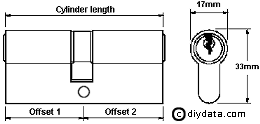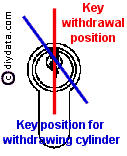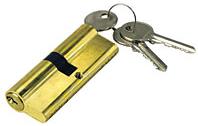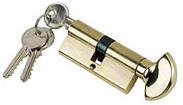Euro Cylinder door lock replacement
removing/refitting a euro cylinder - purchasing a replacement cylinder
 Euro cylinder locks are widely used on uPVC doors, both replacement external doors and conservatories and are often used on other modern doors.
Euro cylinder locks are widely used on uPVC doors, both replacement external doors and conservatories and are often used on other modern doors.
Replacing a euro cylinder lock may be necessary because a set of keys have been lost or you have moved to a new property and want to be confident that there are no keys unaccounted for. In my particular case, I wanted to fit a lock with an internal 'thumb turn' knob for my 90 year old mother to save the family from worrying that she would leave the key in the lock inside so that nobody could unlock the door from outside.
Removing/refitting Euro cylinder
 Although the section of euro cylinders are standard, the length of the cylinder and the offsets about the locating screw hole do vary, so it will probably be necessary to first remove the existing cylinder from the door to measure it, refit it while you purchase a replacement and then go through the removal/replacement procedure again - don't worry, it only requires removing one screw.
Although the section of euro cylinders are standard, the length of the cylinder and the offsets about the locating screw hole do vary, so it will probably be necessary to first remove the existing cylinder from the door to measure it, refit it while you purchase a replacement and then go through the removal/replacement procedure again - don't worry, it only requires removing one screw.
Proceed as follows:
- Unlock and open the door.
- Locate on the edge of the door the cylinder fixing screw, (normally a large headed screw inline with the lower end of the cylinder) remove the screw.
 Next turn the key in the cylinder to bring the cam in line with the body of the cylinder so that it can be withdrawn - the cam is hidden in the door so this has to be judged by feel - it is normally about 25° off of the unlocked key removal position. The illustration right shows the approximate position, but it may be clockwise rather than anticlockwise as shown.
Next turn the key in the cylinder to bring the cam in line with the body of the cylinder so that it can be withdrawn - the cam is hidden in the door so this has to be judged by feel - it is normally about 25° off of the unlocked key removal position. The illustration right shows the approximate position, but it may be clockwise rather than anticlockwise as shown.
Note: If the cylinder fitted has a Thumb Turn knob, there is no need to use a key, just turn the knob to align the cam.- Slide out the cylinder to the key (or Thumb Turn knob) side. If the cylinder catches, try turning the key to about 25° on the other side of the key withdrawal position.
If the cylinder will not slide out of the door, it may be that it is being pinched by the door furniture or the locking mechanism. In this event, the door furniture and/or the locking mechanism may need to be loosened so that the cylinder is free to slide out. - Measure and note the 2 offset dimensions from the fixing screws (see illustration above) - if the offsets are different, note which side of the door each offset applies to.
- If necessary, refit the cylinder in the door until a replacement is purchased - the procedure is just the reverse of removal but the cam can be aligned with the body by eye.
Purchasing a replacement cylinder
 Key style euro cylinder lock |
 Thumb Turn knob euro cylinder lock |
Purchase a replacement euro cylinder having the same offsets as the original - if a Thumb Turn type is to be fitted in place of a double key type (or vista-versa), the offsets still need to be the same as the original. Remember to have any extra keys cut at the time of purchase.
TIPS:
- Check the security grade of the replacement cylinder. Most euro cylinder locks fitted as standard to doors are to standard "EN1303 Grade 3" (medium security); Grade 2 locks are for internal use only, Grade 4 cylinders are high security locks.
- uPVC doors are thicker than wooden doors and some locksmiths may not hold cylinders for these as stock items; it may be worth trying a local uPVC window installer for a suitable cylinder - they may not come with instruction (as they may be intended for the trade) but there is nothing complicated, just follow the instructions above.
